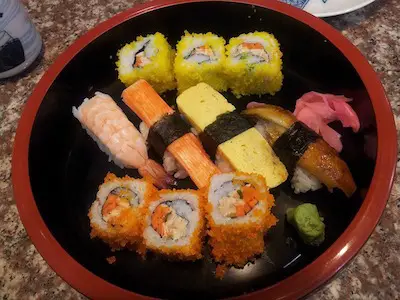We are reader supported. When you purchase through links on our site, we may earn an affiliate commission. Also, as an Amazon affiliate, we earn from qualifying purchases.
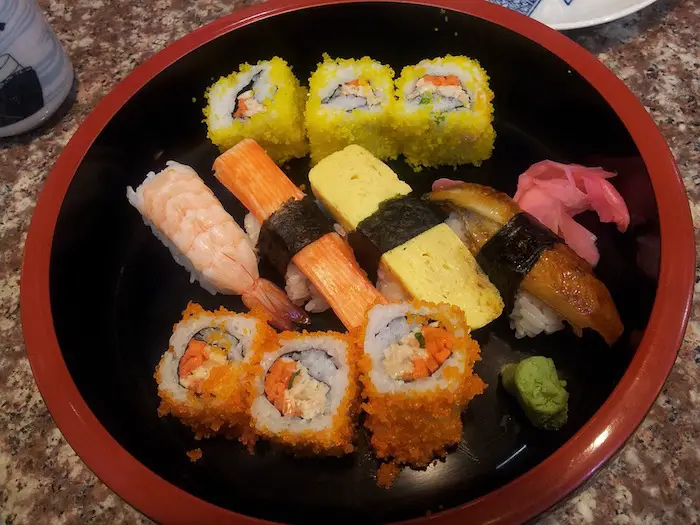
When I hear sushi, my mind immediately conjures up images of nigiri with a glistening slice of raw fish over a bed of seasoned rice. Some people may differ and think of maki rolls covered in deep green seaweed or California rolls with avocado on top. I am sure no one thinks of an egg when talking about sushi, but interestingly they do have a deep connection.
Does sushi have egg? If you are a sushi enthusiast, you have probably heard of tamagoyaki (Japanese sweet egg omelet) which can be used as a topping on nigiri or filling inside a sushi roll. Tempura batter used for making seafood tempura may also contain eggs and let’s not forget the fish eggs (masago and tobiko) that are widely used for garnishing sushi dishes.
So, if you thought eggs didn’t have a place in this Japanese cuisine then you have probably not encountered the above-mentioned delicacies. Chances are you may have eaten them without knowing that they contain eggs. Read on to know more about the types of sushi that contain eggs.
Contents
Tamagoyaki or Tamago
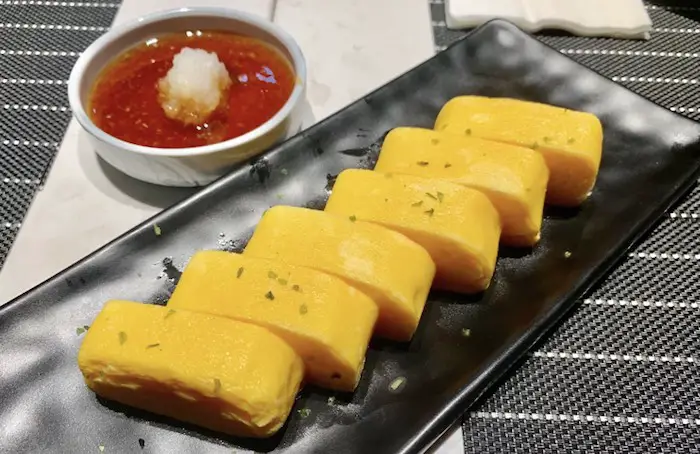
Tamago (see detailed explanation) is a classic-style Japanese egg omelet which is prepared by folding the egg several times on the frying pan. It has a sweet flavor and light texture. The omelet goes well with vinegared sushi rice and is usually accompanied with soya sauce and wasabi for dipping.
Mirin, the Japanese rice wine adds a distinct sweetness to the omelet and dashi gives it a characteristic taste. You can find these ingredients easily in an Asian grocery store or buy online on Amazon. Although sushi beginners may not be familiar with this egg-based ingredient, it is actually a popular Japanese traditional food used in sushi.
A look into sushi history will tell you that the use of egg was not heard of in the Edo period but the Japanese cookbooks published in the mid to late 18th century has mentions of this delicious egg omelet. It went on to become so popular that sushi connoisseurs began judging the skills of a sushi chef by the way he made a tamago.
So, when sushi traditionalists went out to try a new sushi restaurant, they would first order a tamago and if the chef got it right then he was spot on. If not, they took it for granted that the food served at the place will not be of the highest quality.
In some restaurants, tamago is served as a sweet dish after an omakase meal (sushi platter comprising of different types of sushi dishes decided by the chef). The fluffy texture and savory taste of the dish make it the perfect conclusion for a delicious meal.
Tamagoyaki Recipe
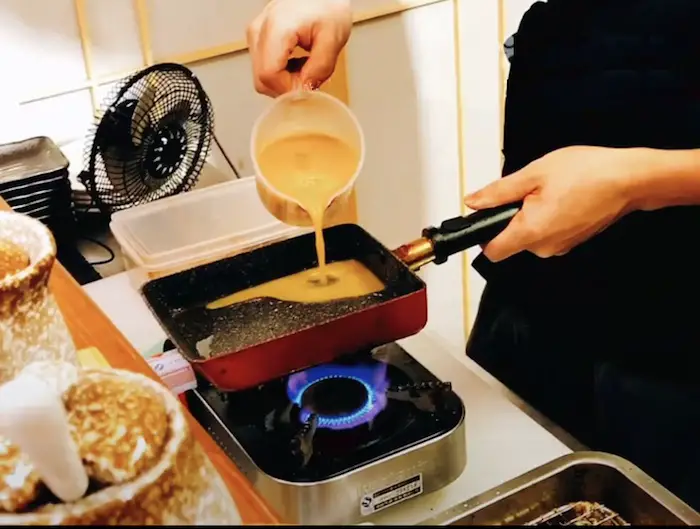
Now that we have talked so much about tamago, let’s take a look at how to prepare it at home. While you may not be able to get it right for the first time, don’t worry much because it will taste great anyway. You can keep practicing until you get a hang of it.
What you will need
- 4 whole eggs
- ¼ cup of dashi stock
- 1 tbsp mirin (Japanese rice wine)
- 1 tbsp white sugar
- ½ tsp soya sauce
- ½ tsp vegetable oil
- A flat-based frying pan like this
Instructions
Take a medium-sized bowl and beat all eggs into it. Add sugar, dashi stock, mirin and soy sauce. Mix it until the sugar dissolves completely.
Now put a frying pan over the gas stove and add vegetable oil to it (make sure you only use frying pan to save yourself from frustration).
Add vegetable oil to the pan and when the oil heats, pour a thin layer of the egg mixture to the pan and swirl it around to cover the entire area.
When the mixture is well-cooked at the bottom and still liquid-y on the top, lift from one end and fold over the remaining egg layer until you reach to the end. Push to one side of the frying pan.
Add some oil again if the pan looks dry and pour some more egg mixture and spread it over the open area as before. When the layer gets firm at the bottom, fold the first omelet roll over the new egg layer again to form a thicker roll.
Keep repeating the above step as long as you have egg mixture in the bowl and by the time you fold the final layer, you will have a thick rolled Japanese omelet ready to eat.
Ways To Use Japanese Egg Omelet (Tamago) In Sushi
You may eat this traditional sweet and savory omelet as a snack or use it as a filling or topping in sushi. To use as a nigiri topping, take a sharp sushi knife and cut the tamago into equal sizes of thickness like that of fish toppings used in sushi. You may attach the tamago slice with sushi rice with a strip of nori.
Another method is to cut the egg omelets into thin strips and use it as fillings in your maki roll. You can pair up the egg strips with avocado and cucumber to add freshness to your roll. Tamago is also a common ingredient used in futomaki roll, which is a popular dish made in holidays or festive events in Japan.
Tempura Batter
If you are a sushi beginner intimidated with the thought of eating raw fish, the safest and crunchiest option for you would be a shrimp tempura sushi roll (find the recipe here). The very mention of this delicacy can make your mouth water once you get to know its taste.
While tempura is not a traditional sushi ingredient, it is a popular dish in most sushi restaurants in the US. The best part is that tempura is not limited to seafood and fish, but you can also use the same batter to make vegetable tempuras using sweet potato, eggplant, mushroom, bell peppers, etc.
Now, coming back to the question of ‘does sushi have egg’. If you are eating sushi that has a tempura filling then it probably does. However, there are several restaurants that may prepare tempura batter without eggs for vegans or those who are allergic to egg. If you are eating out, make sure you ask the sushi chef or server whether the tempura is made with egg or not.
Here’s a typical recipe for making tempura batter with egg:
- 1 cup all-purpose flour
- 2 tbsp cornstarch
- 1 tsp baking powder
- 1⁄2 tsp salt
- 1⁄4 tsp pepper
- Cold water, as needed to make batter consistency
- 1 whole egg, slightly beaten
Beat eggs in a medium-sized bowl until frothy, then add the flour, cornstarch, baking powder, salt, and pepper. Pour cold water slowly and make a batter-like consistency. You may use this batter to make shrimp tempura, prawn tempura, fish tempura, or vegetable tempura for sushi.
Vegan and gluten-free tempura
If you are a vegan or on a celiac diet, you can still enjoy vegetable tempura without egg and any traces of gluten in it. Here’s a gluten-free tempura batter recipe without egg:
- 1 cup of rice flour
- 1 cup of cold club soda
- salt
- canola oil
Mix all the above ingredients to prepare a batter-like consistency. Dip your vegetables and make crunchy tempura to be used as sushi fillings or you may eat them as snacks too. Please remember that gluten-free tempura will have a thinner coat on vegetables but you can still enjoy that amazing flavor and crunchy taste.
Fish Eggs In Sushi
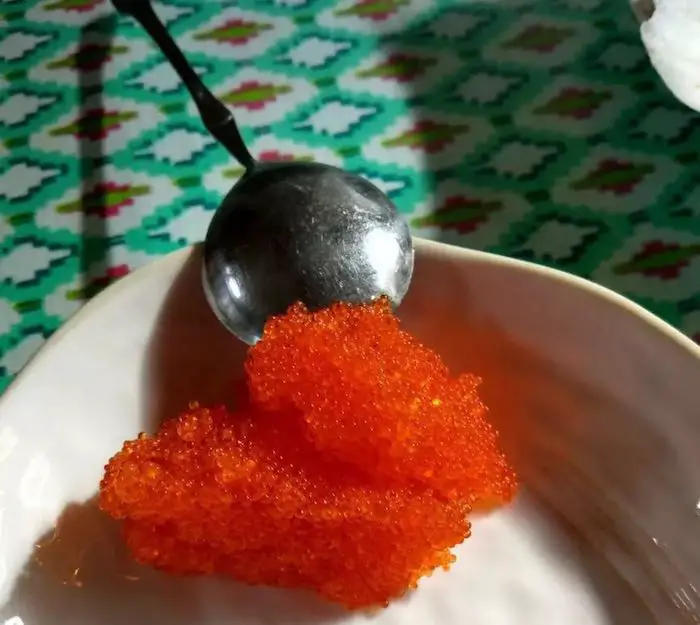
Those who think that sushi does not contain eggs, probably forget one of the most popular ingredients, which is a popular delicacy in Japan – the fish eggs. The orange round balls you see decorated outside an uramaki roll are fish eggs and they are known by names like – tobiko, masago, ikura, etc.
Interestingly, there are nine different types of fish eggs used in Japanese traditional sushi, however, these three are the most well-known. While tobiko and masago are not typically poultry eggs, they are eggs after all!
Tobiko is the flying fish roe and it has a red-orange color. It has a mildly salty taste with a distinctive crunchiness that sets it apart from others. The chefs may often dye tobiko with various food to make it red, green, yellow or black.
Masago is also known as the smelt roe. It typically comes from the Capelin fish that belongs to the smelt family and it is found in northern Atlantic and Pacific ocean. Distinguished by its red-orange color, masago is a common ingredient used in sushi dishes.
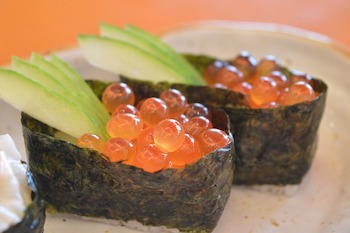
Ikura is salmon eggs and it also has a red-orange color. The salmon roe is bigger in size than masago and it must be handled delicately. It has a mushy texture and if punctured, the sweet liquid may spill out. I have created an article that contains information about different fish eggs used in sushi and includes recipes too – What Are Fish Eggs On Sushi Called.
If you are looking for a reliable source to get frozen fish eggs or seafood, checkout Catalina Offshore Products. It has a wide range of products and their shipping
Related Questions
What sushi should I order if I have egg allergies
If you are allergic to egg, order any type of sushi that contains raw fish or seafood as they don’t contain eggs. Stay away from fried ingredients in sushi as they may or may not contain eggs. When dining out, let the sushi chef know about your dietary restriction and avoid ordering an omakase meal.
What kind of sushi is covered with fish eggs
The inside-out California style roll has vinegared rice on the outside to hide the seaweed under the layer of rice. As rice is sticky, it is often covered with toasted sesame seeds or fish eggs to add a crunchy texture. Common examples are Dragon sushi rolls, Dynamite rolls, Fire rolls, Rain, tobiko rainbow rolls and so on.
Does sashimi contain eggs?
No, sashimi is different from sushi as it mainly comprises of a precisely cut thin slice of raw fish or seafood. It may often be cured with vinegar and garnished with shiso leaves and sesame seeds.
Does chirashi sushi have egg?
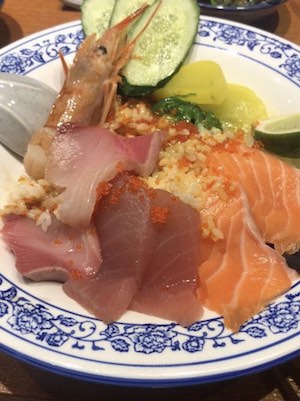
Yes, a chirashi bowl (see more detailed explanation) contains an assortment of fish, seafood, and other sushi ingredients arranged over a bed of seasoned sushi rice. Tamagoyaki is a common ingredient used in chirashizushi to add sweetness and savory taste to the bowl.
